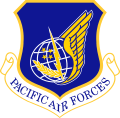12th Special Operations Squadron  | |
|---|---|
 | |
| Active | 1941–2007; 2015–present |
| Country | |
| Branch | |
| Role | Special operations |
| Part of | Air Force Special Operations Command |
| Garrison/HQ | Cannon Air Force Base |
| Nickname(s) | Dirty Dozen (World War II) |
| Motto(s) | In Omnia Paratus (Latin) Ready for Anything (1957-present) |
| Engagements | Southwest Pacific Theater Korean War Vietnam War [1] |
| Decorations | Distinguished Unit Citation Presidential Unit Citation Air Force Outstanding Unit Award with Combat V device Air Force Outstanding unit Award Philippine Presidential Unit Citation Korean Presidential Unit Citation Republic of Vietnam Gallantry Cross with Palm [1] |
| Commanders | |
| Current commander | Lt Col Joshua E. Swann[ citation needed ] |
| Insignia | |
| 12th Special Operations Squadron emblem [note 2] [1] |  |
| 12th Fighter Squadron emblem [note 3] [2] |  |
| 12th Fighter Squadron emblem (World War II) [3] |  |
The 12th Special Operations Squadron is assigned to the 27th Special Operations Group at Cannon Air Force Base, New Mexico. Its mission is the launch and recovery of MQ-9 Reaper Remotely Piloted Aircraft from unprepared locations throughout the world. The squadron was activated in 2015 to replace a detachment that had been performing the same mission since October 2013. [4]
Contents
- History
- World War II
- Korean War
- Vietnam War
- Operations in the Pacific
- Remotely piloted vehicles
- Lineage
- Assignments
- Stations
- Aircraft
- Awards and campaigns
- References
- Notes
- Bibliography
The squadron was previously active at Elmendorf Air Force Base, Alaska as the 12th Fighter Squadron, part of the 3d Operations Group. The squadron operated the McDonnell Douglas F-15 Eagle aircraft conducting air superiority missions.
The mission of the 12th is to launch and recover Remotely Piloted Aircraft (RPA) operationally employed by the 2d, 3d and 33d Special Operations Squadrons. To avoid the inherent delay in transmitting commands through satellite communications to RPAs from distant stations, the squadron deploys to locations where it can operate the craft for takeoff and landing using line of sight signals. This minimizes risk during critical flight operations, while permitting mission operations to be performed from more remote secure locations. [4]




